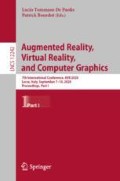Abstract
The use of UAVs has recently been proposed for services in civil airports and other sensitive areas. Besides specific regulations from authorities, the situation awareness of the UAV operator is a key aspect for a safe coexistence between manned and unmanned traffic. The operator must be provided in real-time with contextually relevant information, in order to take the proper actions promptly based on the notified contingency. Augmented reality can be adopted to superimpose such additional information on the real-world scene. After the definition of an architecture for the integration of drone operations in the airspace, in this paper the interface and the layout of an augmented reality application for the situation awareness of the pilot are designed and discussed.
Access this chapter
Tax calculation will be finalised at checkout
Purchases are for personal use only
References
Federal Aviation Administration: Operation and Certification of Small Unmanned Aircraft Systems. Technical report (2016)
Ren, L., et al.: Small unmanned aircraft system (sUAS) categorization framework for low altitude traffic services. In: Proceedings of the AIAA/IEEE Digital Avionics Systems Conference, pp. 1–10 (2017)
Giulietti, F., Pollini, L., Avanzini, G.: Visual AIDS for safe operation of remotely piloted vehicles in the controlled air space. Proc. Inst. Mech. Eng. Part G J. Aerosp. Eng. 230(9), 1641–1654 (2016)
Kopardekar, P., et al.: Unmanned aircraft system traffic management (UTM) concept of operations. In: 16th AIAA Aviation Technology, Integration, and Operations Conference (2016)
Mattei, A.P., et al.: UAV in - flight awareness: a tool to improve safety. In: 5th European Conference for Aerospace Sciences (EUCASS), p. 15 (2013)
Templin, F.L., et al.: Requirements for an integrated UAS CNS architecture. In: Integrated Communications, Navigation and Surveillance Conference (ICNS), pp. 2E4-1-2E4-11 (2017)
Avanzini, G., Martínez, D.S.: Risk assessment in mission planning of uninhabited aerial vehicles. Proc. Inst. Mech. Eng. Part G J. Aerosp. Eng. 233(10), 3499–3518 (2019)
Rebane, G.: EASA basic regulation: improving the performance of the european aviation safety system. Zeitschrift fur Luft- und Weltraumrecht - German J. Air Space Law 68, 51 (2019)
Endsley, M.R.: Toward a theory of situation awareness in dynamic systems (2017)
Endsley, M.R.: Designing for situation awareness in complex systems. In: Second International Workshop on Symbiosis of Humans, Artifacts and Environment, pp. 1–14 (2001)
Wither, J., DiVerdi, S., Höllerer, T.: Annotation in outdoor augmented reality. Comput. Graph. (Pergamon) 33(6), 679–689 (2009)
Ruano, S., et al.: Augmented reality tool for the situational awareness improvement of UAV operators. Sensors (Switzerland) 17(2), 297 (2017)
Zollmann, S., et al.: Image-based X-ray visualization techniques for spatial understanding in outdoor augmented reality. In: Proceedings of the 26th Australian Computer-Human Interaction Conference, OzCHI 2014, Sydney, New South Wales, Australia, pp. 194–203 (2014)
Zollmann, S., et al.: FlyAR: augmented reality supported micro aerial vehicle navigation. IEEE Trans. Vis. Comput. Graph. 20(4), 560–568 (2014)
Cai, Z., Chen, M., Yang, L.: Multi-source information fusion augmented reality benefited decision-making for unmanned aerial vehicles: a effective way for accurate operation. In: Proceedings of the 6th IEEE Conference on Industrial Electronics and Applications, ICIEA 2011, pp. 174–178 (2011)
Wu, H., Cai, Z., Wang, Y.: Vison-based auxiliary navigation method using augmented reality for unmanned aerial vehicles. In: IEEE 10th International Conference on Industrial Informatics (INDIN), pp. 520–525 (2012)
Iwaneczko, P., Jędrasiak, K., Nawrat, A.: Augmented reality in UAVs applications. In: Nawrat, A., Jędrasiak, K. (eds.) Innovative Simulation Systems. SSDC, vol. 33, pp. 77–86. Springer, Cham (2016). https://doi.org/10.1007/978-3-319-21118-3_6
ISO: Human-centred design for interactive systems. Ergonomics of human system interaction. Part 210. ISO 9241–210 (2010)
De Paolis, L.T., De Luca, V.: Augmented visualization with depth perception cues to improve the surgeon’s performance in minimally invasive surgery. Med. Biol. Eng. Comput. 57(5), 995–1013 (2018). https://doi.org/10.1007/s11517-018-1929-6
Maiouak, M., Taleb, T.: Dynamic maps for automated driving and UAV geofencing. IEEE Wireless Commun. 26(4), 54–59 (2019)
Zhu, G., Wei, P.: Low-altitude UAS traffic coordination with dynamic geofencing. In: 16th AIAA Aviation Technology, Integration, and Operations Conference (2016)
Epson Moverio BT-300 Drone FPV, Edition, June 2020. https://www.epson.eu/products/see-through-mobile-viewer/moverio-bt-300-drone-fpv-edition
Unity3D, June 2020. https://unity3d.com/
Razzanelli, M., et al.: A visual-haptic display for human and autonomous systems integration. In: Hodicky, J. (ed.) MESAS 2016. LNCS, vol. 9991, pp. 64–80. Springer, Cham (2016). https://doi.org/10.1007/978-3-319-47605-6_6
Message Queuing Telemetry Transport, June 2020. http://mqtt.org/
Author information
Authors and Affiliations
Corresponding author
Editor information
Editors and Affiliations
Rights and permissions
Copyright information
© 2020 Springer Nature Switzerland AG
About this paper
Cite this paper
Avanzini, G., De Luca, V., Pascarelli, C. (2020). AR-Based Visual Aids for sUAS Operations in Security Sensitive Areas. In: De Paolis, L., Bourdot, P. (eds) Augmented Reality, Virtual Reality, and Computer Graphics. AVR 2020. Lecture Notes in Computer Science(), vol 12242. Springer, Cham. https://doi.org/10.1007/978-3-030-58465-8_22
Download citation
DOI: https://doi.org/10.1007/978-3-030-58465-8_22
Published:
Publisher Name: Springer, Cham
Print ISBN: 978-3-030-58464-1
Online ISBN: 978-3-030-58465-8
eBook Packages: Computer ScienceComputer Science (R0)

